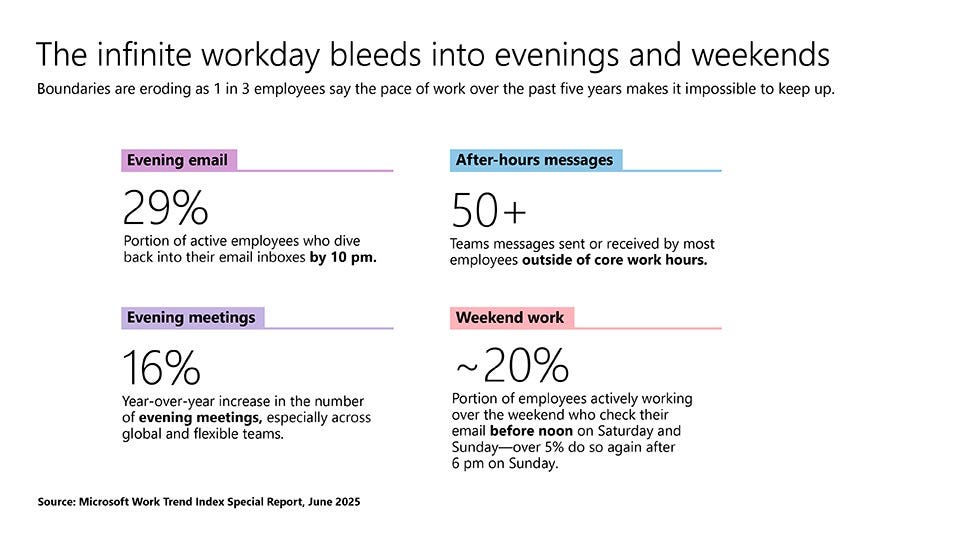From Sunday Scaries to Late-Night Meetings: Microsoft Confirms the Workday Has No Off Switch
Microsoft’s latest report reveals how nonstop digital demands are blurring work-life boundaries—and why AI alone won’t solve burnout without a new mindset

The traditional 9-to-5 workday is rapidly unraveling, replaced by what Microsoft calls the “infinite workday,” a nonstop cycle that begins even before we’re out of bed and stretches late into the night and also into the weekends. The line between work and life has all but disappeared. Microsoft argues that without meaningful change, this trend will only accelerate. The company suggests a new approach—the “Frontier Firm mindset”—to work that rethinks how time is spent, how teams operate, and what actually drives impact.
In April, Microsoft proposed that business leaders embrace artificial intelligence and become what it termed “Frontier Firms.” These AI-first organizations pair human workers with AI agents to reimagine the future of work. Two months later, Microsoft has released an update, arguing that merely adopting AI isn’t enough to navigate digital transformation. While AI is boosting productivity by automating routine tasks and freeing up employees for more creative, strategic work, without careful planning, companies risk filling that freed-up time with even more demands, further fueling the infinite workday.
Infinite Workdays Leave No Room For Actual Work
To illustrate how much hustle culture has ingrained itself into work, Microsoft analyzed “trillions” of aggregated and anonymized Microsoft 365 productivity signals worldwide. Today, 40 percent of workers are checking their messages as soon as they wake up. On average, they’ll receive 117 emails per day, most of which will likely be quickly skimmed over. This is compounded by the fact that the emails will involve more than 20 people—these mass mailings are up seven percent from last year.
Once workers arrive in the office, apps like Microsoft Teams often replace email as the primary communication channel. It’s where they’ll receive a daily average of 153 messages. Productivity slows down further as workers sit in meetings—Microsoft claims half of all meetings take place between 9 a.m. and 11 a.m. and 1 p.m. and 3 p.m., which leaves little room for deep focus. And any “free” time that might be spent on writing, analyzing data, creating presentation decks, or other actual work is not consistent. Microsoft 365 data shows workers are interrupted every two minutes, either by a meeting, email, or notification.
The workday used to end at 5 p.m., but now it’s more common to have later-in-the-day meetings (those that take place after 8 p.m. are up 16 percent annually, thanks to global and flexible teams). And communication doesn’t come to a halt either: On average, workers will send or receive more than 50 messages outside of core business hours. And by 10 p.m., nearly a third will jump back into their work.
To put it simply, it’s a prime environment that can lead to unhappy morale and worker burnout.
Microsoft’s update to the Work Trend Index should serve as a warning to workers and business leaders. Such a level of productivity—if it can even be called that—isn’t sustainable. And with employees stretched thin and sacrificing work-life balance for their organizations, they run the risk of being part of the group that’s let go when it’s time to reduce the workforce, especially when executives claim that AI will perform their duties just as well, if not better.
Microsoft’s “Frontier Firm” Mindset
So what’s the way forward? Microsoft outlines several starting points, all rooted in a fundamental rethink of how AI should shape the future of work. Executives can celebrate transforming their organizations into AI-first firms, patting themselves on the back by having human employees paired with bots, but it’s not a magic bullet. Simply adding technology won’t alleviate workloads—it requires a shift in perspective.
It starts with following the Pareto Principle, or the 80/20 rule. Microsoft describes it as focusing on 20 percent of the work that delivers 80 percent of the outcomes. “By deploying AI and agents to streamline low-value tasks—status meetings, routine reports, admin churn—leaders can reclaim time for what moves the business: deep work, fast decisions, and focused execution,” it writes in a blog post. In other words, think smarter, not harder, with AI.
Next, Microsoft proposes businesses rethink their work chart. The days of rigid team structures are over with on-demand AI and agents, it claims. Instead of organizing teams by function, embrace a more agile, outcome-driven model “in which lean teams form around a goal and use AI to fill skill gaps and move fast.”
Lastly, human employees should be “agent bosses.” It’s a characteristic identifiable with “Frontier Firms” in which workers manage one or more AI agents.
In reality, the mindset Microsoft is promoting here isn’t exactly new. It’s a rehash of ideas the company introduced in April with its 2025 Work Trend Index. Will these steps genuinely lead to systemic changes in how we work? Or is it better that organizations reflect on their culture and business processes and start there?
Regardless of Microsoft’s guidance, one thing is clear: modern work has fractured. Employees face fragmented schedules, rising demands, and nonstop digital noise. The traditional 9-to-5 job is essentially a myth today, and the boundary between work and life has all but vanished. Technology helped create this blur. The question is whether it, paired with greater intentionality, can help us find our way out.






